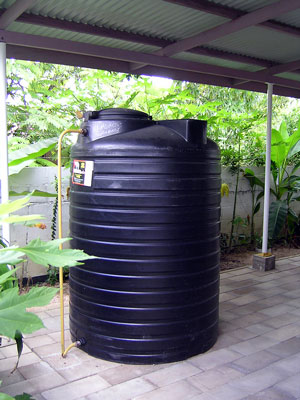
By Jacki Brown, MAILDM
People use water in landscapes because of the aesthetic benefits provided — directly, such as in water features, and indirectly by helping plants to grow and flourish. Gardens are a place of life and water is necessary for all life, but in today’s climate of drought, flooding and environmental concerns, our relationship with water can be tempestuous. However, sensible water use does not have to mean dead lawns and cacti. There are many design solutions available to you, including recycling water, reducing water loss, appropriate plant selection and water management.
Water in the landscape can have a cooling effect on the microclimate, making spaces more comfortable and pleasant to be in. Water can also have psychological benefits. The sound of water is very calming and gazing at the reflection of light on a pool of water has a meditative effect. Of course you need to consider how you will fill (and refill) your water feature so proper placement is important. Ponds located in a hot, paved area, or a feature that splashes a lot, will lose more water and need to be refilled more frequently.
A major part of water management is the planning stage. Some important factors you need to identify are: how much water is available (from rainfall or recycled water); how much storage space is available; your soil’s ability to store water; the individual water needs of your plants; the total amount of water required for your garden; and whether you already have areas in the garden that are typically wet or dry.
Water can be sourced and stored in several ways in a home setting. Sources of water include rainwater collected from the roof; stormwater collected from ground surfaces; greywater recycled from your laundry or shower; and bore water pumped out of the ground. Rainwater can be stored in underground or aboveground tanks of various styles and sizes, either pre-made or custom-designed. Regulations governing the use of greywater vary from state to state, but untreated greywater must never be stored for more than 24 hours and it should always be used with a sub-surface irrigation system.
Don’t forget that water is also stored in the soil, so a good covering of mulch will conserve this supply. The type and condition of your soil can affect the management of water. Whether the soil is sandy or clay, hydrophobic (water repellant), or compacted will determine how much water can be held by your soil and also how quickly it will infiltrate. Your soil may need improvements such as mulch, compost or decompaction to improve its water-holding capacity depending on your existing site conditions.
Some issues to do with water in the landscape extend beyond your back fence so it is important to remember that anything you do in your backyard may have a flow-on effect into the wider landscape. A landscape designer has an understanding of overland and sub-surface water flows, the effects of fertiliser or pesticide leaching and salinity, which will ensure your garden has a positive effect on neighbouring properties and nearby waterways.
Water restrictions make it even more important to use appropriate plants, especially indigenous native species, which can cope with the local conditions and require less or no irrigation or fertilisers and pesticides, thus reducing contamination of groundwater and stormwater. Another useful strategy is to create plant water use zones by grouping drought-tolerant plants together in drier areas or areas that are further away from your hose, and by grouping more thirsty plants in damper areas or areas closer to your hose.
Although irrigation is not necessary in all areas of your garden, it can be a good solution for supplementary watering and to disburse water collected in tanks. It is best to encourage deep roots by watering less often but for longer periods rather than shorter periods more often. By doing this you will encourage plant roots to grow deep into the soil where they have a better chance of accessing water during dry periods.
If you have areas in your garden that receive periodic inundation or are damp, you can install sub-surface drainage, or plant plants that grow well in damp or waterlogged soils. Sub-soil drainage may be a useful option uphill of structures or paved areas to prevent damage and decay of materials, but it is a necessity behind retaining walls.
Water cycles through the landscape and it will have an impact on all facets of your garden, so it is important to engage a landscape designer if you want your garden to thrive. We may have to come to terms with the loss of the Slip ‘n’ Slide but at least the humble water feature can still have its place in the Australian garden.
This article was prepared by Jacki Brown and the team at ecodesign on behalf of the Australian Institute of Landscape Designers & Managers (AILDM). If you would like to find an AILDM member in your area, visit the website: www.aildm.com.au






